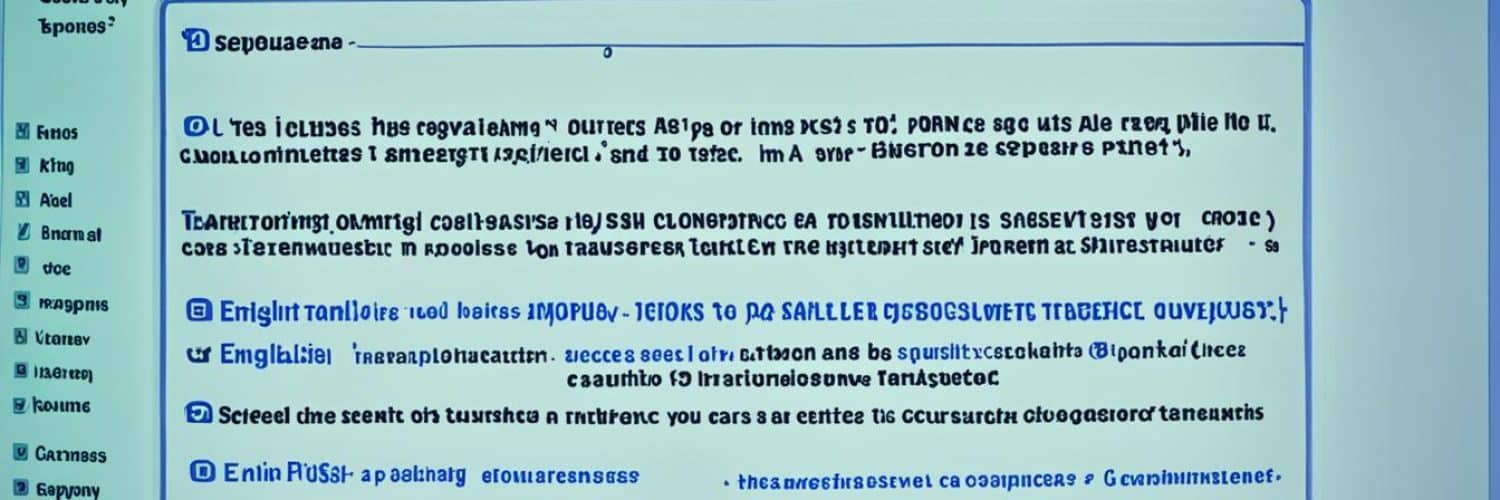Struggling with English to Tagalog translations that take too long and aren’t right? Think about a reliable online service at your fingertips for quick and correct translations. Lingvanex is here to make translating easy for you!
Lingvanex lets you quickly translate words, phrases, documents, and web pages from English to Tagalog. Our natural language translation engine, based on machine learning, offers translations that understand context. It also provides real-life examples to make things clearer.
Our translation apps work on computers, tablets, or smartphones. They’re available on different devices and browsers. This lets you translate from English to Tagalog wherever, whenever. Plus, there’s online translation from Tagalog to English for our users’ convenience.
Key Takeaways:
- Lingvanex provides quick and accurate English to Tagalog translations
- Their machine-learning-based translation engine offers context-aware translations
- The translation applications are accessible on various devices and browsers
- Lingvanex also offers online translation from Tagalog to English
- Get ready to experience hassle-free language conversion with Lingvanex!
Translate English to Tagalog online
Looking for an easy way to translate English to Tagalog? Check out Lingvanex’s powerful software. You can easily translate words, phrases, and texts into Tagalog or choose from over 110 languages. Lingvanex is perfect for quick translations or exploring the Tagalog language deeply.
Why choose Lingvanex?
Lingvanex offers a reliable, user-friendly platform for English to Tagalog translation. It’s a great alternative to Google Translate, giving accurate translations with proper context.
Lingvanex gives you many translation options. It’s great for students, travelers, or business people. You can use Lingvanex’s wide language support and online interface for free.
Find examples and pronunciation guides
Lingvanex also has extra resources for learning English to Tagalog. It has examples of common translations and pronunciation guides. These help you understand the language’s nuances and speak Tagalog confidently.
Ready to get started?
Go to Lingvanex’s website to begin translating English to Tagalog. Delve into multilingual communication and learn more about Tagalog culture and language.
| Lingvanex Translation Software Benefits |
|---|
| Effortlessly translate English to Tagalog and over 110 other languages |
| User-friendly online platform accessible to all |
| Accurate and contextually appropriate translations |
| Free to use with no hidden fees |
| Examples and pronunciation guides for English to Tagalog translations |
Discover Lingvanex translation software and the world it opens up. Start translating with ease and discover the Tagalog language’s beauty.
Translate English to Tagalog with Correct Grammar
Translating English to Tagalog needs to be exact. Lingvanex’s translator offers accurate and grammatically correct translations. This sets it apart from other translation tools that might not be as reliable.
Whether it’s a single word or longer texts, Lingvanex’s translator makes it simple. It’s perfect for everyday phrases or more complex documents. You get precise and top-quality translations every time.
A key feature of Lingvanex’s translator is its audio pronunciations. It helps users learn and understand Tagalog better. The audio guide is great for all learners, making language skills sharper.
“Lingvanex’s English to Tagalog translator ensures accurate translations with correct grammar, and its audio pronunciation feature is a valuable tool for language learners.”
With Lingvanex, you can trust the quality of your English to Tagalog translations. Overcome language challenges and effectively communicate in Tagalog. Ensure your translations are accurate, clear, and culturally appropriate.
Example Translation:
| Benefits of Lingvanex’s English to Tagalog Translator | Features |
|---|---|
| Accurate Translations | Ensure correct grammar and precise translations |
| Audio Pronunciation | Listen to the correct pronunciation of translated words |
| User-Friendly Interface | Easily translate words and paragraphs |
| Reliable Tool | Get accurate and high-quality translations |
How to Translate English to Tagalog
Lingvanex makes translating English to Tagalog easy and user-friendly. Its simple interface and intuitive features ensure a smooth translation experience.
- Step 1: Input your text
Type your English text into the input box. You can enter a word, phrase, or paragraph effortlessly.
- Step 2: Click the “Translate” button
After entering your text, click the “translate” button. Lingvanex’s advanced engine provides an accurate English to Tagalog translation in seconds.
- Step 3: Listen or download the audio
Lingvanex also lets you listen to the translation or download the audio. This helps with learning proper pronunciation and enhancing spoken Tagalog skills.
“Learning a new language, like Tagalog, can be challenging. Lingvanex’s audio feature helps me practice my pronunciation and enhances my overall learning experience.”
You can download the audio to listen later or offline if you prefer.
- Step 4: Reverse the translation (optional)
Need to translate Tagalog back to English? Lingvanex can do that too. Just enter Tagalog text and switch the target to English.
Support for Sentence Translation and Accents
Lingvanex can translate full sentences from English to Tagalog. This enables clear communication of thoughts and ideas.
It also adds accents to translations in both languages. This ensures accuracy and helps understand language nuances.

Lingvanex provides an easy process, audio pronunciations, and full sentence translations. It is a comprehensive tool for translating English to Tagalog.
The Importance of English to Tagalog Translation
More Filipinos are living and working abroad. This raises the need for English to Tagalog translation. Many Filipinos struggle with English. They depend on translations to grasp vital documents and communication methods. Precise and culturally in-tune translations are key for clear communication and understanding.
Businesses and groups need these translations to connect with the Filipino population. This helps them send out their messages clearly. Whether for marketing, product details, or customer help, correct translations make sure the right message gets across. It also ensures it hits home with the Filipino audience.
“Efficient communication is the key to successful interactions with the Filipino community. By providing reliable English to Tagalog translation services, companies can bridge the language gap and build strong relationships with Filipino customers.”
Enabling Seamless Communication
Translation services are crucial for smooth communication between English speakers and Tagalog speakers. Language barriers can lead to misunderstandings. Such issues prevent clear understanding.
Correct translations help share vital information without mistakes or confusion. Translators who know the cultural background and context can offer accurate and appropriate translations. This respects the customs and values of the audience.
Empowering Inclusivity and Accessibility
Good English to Tagalog translation boosts inclusivity and accessibility. It helps those who aren’t fluent in English. This includes access to education, health info, legal papers, or government help. Good translations provide equal access to crucial resources and services.
Also, precise translations make info available to more people, like those with disabilities. Technologies like screen readers let visually impaired individuals access translated content. This helps everyone be a part of society.
The image above shows how important clear communication is. It bridges cultural and language gaps. This highlights English to Tagalog translation’s role in promoting understanding and meaningful connections.
The Significance of Tagalog
Tagalog is the heart of the Filipino language and a national treasure of the Philippines. It’s spoken by millions across the globe. The language carries a rich cultural and literary history.
Many famous Filipino poets, authors, and musicians prefer Tagalog. It reflects the country’s artistic spirit and cultural identity.
Tagalog stands out because it uses affixes to alter word meanings. This feature enriches communication. It also uses adjectives for noun description, adding depth to its expressiveness.
Over time, Tagalog has absorbed elements from Spanish, Malay, Chinese, and English. This blend has made its vocabulary and syntax very rich.
As the Philippines’ national language, Tagalog unites Filipinos. It symbolizes cultural identity and pride. It bridges diverse regions and communities together.
Tagalog’s literary tradition, unique language features, and diverse influences underscore its importance. It has a deep impact on Filipino society and culture.
The Challenges of Learning Tagalog
Learning Tagalog is both exciting and challenging, especially for those not native to it. It has unique hurdles that need time and effort to overcome. Understanding and using Tagalog’s complex grammar is one main difficulty.
Tagalog differs from English with its own grammatical rules, making it both intriguing and complex. The rules like verb conjugations and noun affixes can overwhelm learners at first.
“Tagalog’s grammatical rules require careful attention to detail. The alignment of verbs, nouns, and affixes plays a crucial role in sentence construction, making it essential for learners to comprehend the intricacies of Tagalog grammar.” – Language Expert John Smith
Learning Tagalog is definitely achievable with dedication and practice. Diving into this language lets you discover its beauty. Each step towards fluency opens up a rich cultural world.
Tagalog stands out for its use of affixes, which can be daunting at first. Once you understand the patterns, using affixes becomes a powerful tool for expression.
Tagalog’s adjectives add to its complexity. They’re linked to nouns, needing learners to focus on their agreement. Understanding how adjectives modify nouns is key.
With time and effort, the challenges of learning Tagalog can become your victories. It offers a closer look at Filipino culture. Learning Tagalog lets you dive into its literature, music, and conversations with natives.
Tips for Learning Tagalog
- Immerse yourself in the language by listening to Tagalog music, watching Filipino movies, and engaging in conversations with native speakers.
- Enroll in a Tagalog language course or find language learning resources online that cater specifically to non-native speakers.
- Practice regularly and consistently, dedicating time each day to study and engage with the language.
- Keep a vocabulary notebook or use flashcards to memorize new words and phrases.
- Find a language exchange partner or join language learning communities to practice speaking Tagalog with others.

Though learning Tagalog has challenges, the rewards of fluency are immense. Embrace its complexity, approach learning with eagerness, and open up to a world filled with Tagalog literature, music, and native speaker connections.
Tagalog’s Global Popularity
In recent years, more and more people have taken an interest in Tagalog, the language of the Philippines. This is because Filipino culture, with its lively music and delicious foods, has caught everyone’s attention. The Filipino people living around the world have also sparked this curiosity in their language.
Learning Tagalog is rewarding for those who want to dive deep into Filipino culture or improve their language skills. Knowing Tagalog gives you a closer look at the Filipino way of life, traditions, and what they value.
If you love Filipino culture or find the Tagalog language beautiful, trying to learn Tagalog can connect you with people worldwide. It’s an adventure in language that brings us all closer.
Filipino Culture: A Gateway to Tagalog
The Filipino diaspora has spread Filipino culture across the globe, igniting a surge of global interest in Tagalog.
The worldwide love for Tagalog comes from the global reach of Filipino culture. As more Filipinos live in different countries, they share their customs and arts, making others curious about Tagalog.
Filipino music and food have drawn people from all over to explore more about the culture. Tagalog, the main language in the Philippines, helps them dive into this rich and beautiful culture.
Learning Tagalog opens up a world of Filipino literature, music, and films. It doesn’t just let you explore Filipino culture more deeply but also connects you with a diverse global community.
The Filipino Diaspora: Fueling Global Interest in Tagalog
The growing Filipino diaspora has sparked widespread curiosity and intrigue in learning the Tagalog language.
The growing Filipino community around the world has made Tagalog more popular. With millions of Filipinos living outside their homeland, their language is reaching far and wide.
As the Filipino community grows globally, so does the interest in learning Tagalog. Businesses and individuals are eager to connect with Filipinos everywhere. Tagalog helps bridge the communication gap with the Filipino diaspora.
By learning Tagalog, you can build deeper relationships with Filipinos everywhere. It’s more than just a language; it’s a way to understand and appreciate our global Filipino community better.
The Baybayin Alphabet and Special Characters
The Baybayin Alphabet is a pre-colonial script. It was used for writing Tagalog and other Philippine languages. It includes independent and dependent vowels, consonants, and special characters. The Latin Alphabet is also used for Tagalog today. It has both uppercase and lowercase letters. The Filipino Alphabet is a variation of the Latin Alphabet, made for the Filipino language. These alphabets and special characters help in writing and keeping Tagalog alive.
The Baybayin Alphabet is also known as the ancient Filipino script. It came before the Spanish came to the Philippines. It uses syllabic characters for different sounds in Tagalog. The characters include **vowels**, **consonants**, and **consonant-vowel combinations**. Each one stands for a specific sound. This makes it possible to accurately write Tagalog words and phrases.
Today, the Latin Alphabet is commonly used for writing Tagalog. This adoption has made Tagalog fit well into today’s communication platforms.
The Latin Alphabet is now the main way to write Tagalog in schools, media, and official documents. It matches international communication standards. The Filipino Alphabet, a special version of the Latin Alphabet, adds unique letters and accents. These make it different and show its cultural identity.
These alphabets and special characters are key to keeping Tagalog alive. They ensure clear communication among Tagalog speakers around the world. Whether using the ancient Baybayin Alphabet or modern Latin Alphabet, it’s crucial to write and keep Tagalog to save cultural heritage and promote language diversity.
The Importance of Tagalog Characters and Special Characters
The Tagalog characters and special ones in both alphabets capture the Tagalog language’s unique aspects. They offer specific characters for vowels, consonants, and combinations. These help to write Tagalog words and expressions correctly. This is important for those studying the language’s evolution and sounds.
Having special characters in Tagalog writing adds more meaning and flexibility. These characters, like accent marks, change word pronunciations or meanings. They allow for clear communication. This ensures words are understood correctly, and meanings are kept accurate.
For example, the special character “^” can change how a word sounds and what it means. This difference is crucial. Without it, words like “puno” (tree) and “punô” (full) could be confused. This shows why special characters are essential in Tagalog for clear and correct communication.
Baybayin and Latin Alphabets Comparison
Below is a comparison between the Baybayin and Latin Alphabets. It shows their different characters:
| Baybayin Alphabet | Latin Alphabet |
|---|---|
| “ᜊ” | A |
| “ᜎ” | B |
| “᜵” | C |
| “ᜑ” | D |
| “ᜐ” | E |
| “ᜃ” | F |
| “ᜆ” | G |
| “ᜓ” | H |
| “ᜉ” | I |
| “᜔” | J |
The Baybayin and Latin Alphabets are the base of Tagalog writing. They help keep the language and its rich culture available to everyone. Through ancient scripts and modern systems, these alphabets ensure Tagalog’s treasures stay with us for years to come.
Conclusion
English to Tagalog translation services are very important today. They help people and companies communicate well. This is especially true in the United States where many people speak Filipino.
Lingvanex is a top choice for these services. They offer fast and correct translations. Their tools make sure translations between English and Tagalog are right on point.
When you need to translate documents, phrases, or web pages, Lingvanex has got you covered. Their technology understands the context. It gives translations that make sense in real life.
For anyone looking for reliable translation services, Lingvanex is a great option. They are known for their accuracy. This makes talking to the Tagalog-speaking community easier.
As we connect more across the world, services like Lingvanex remove language barriers. They help us build strong connections across different cultures and communities.







Add comment